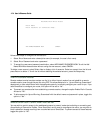
11-12 User’s Reference Guide
By default, the read-only and read/write community strings are set to “public” and “empty,” respectively. You
should change the default community strings to values known only to you and trusted system administrators.
To change a community string, select it and enter a new value.
Caution! Even if you decide not to use SNMP, you should change the community strings. This prevents
unauthorized access to the Netopia R310 through SNMP. For more information on security issues, see
“Suggested security measures” on page 12-1.
SNMP traps
An SNMP trap is an informational message sent from an SNMP agent (in this case, the Netopia R310) to a
manager. When a manager receives a trap, it may log the trap as well as generate an alert message of its own.
Standard traps generated by the Netopia R310 include the following:
■ An authentication failure trap is generated when the router detects an incorrect community string in a
received SNMP packet. Authentication Traps Enable must be On for this trap to be generated.
■ A cold start trap is generated after the router is reset.
■ An interface down trap (ifDown) is generated when one of the router’s interfaces, such as a port, stops
functioning or is disabled.
■ An interface up trap (ifUp) is generated when one of the router’s interfaces, such as a port, begins
functioning.
The Netopia R310 sends traps using UDP (for IP networks).
You can specify which SNMP managers are sent the IP traps generated by the Netopia R310. Up to eight
receivers can be set. You can also review and remove IP traps.
To go to the IP Trap Receivers screen, select IP Trap Receivers. The IP Trap Receivers screen appears.
IP Trap Receivers
Display/Change IP Trap Receiver...
Add IP Trap Receiver...
Delete IP Trap Receiver...
Return/Enter to modify an existing Trap Receiver.
Navigate from here to view, add, modify and delete IP Trap Receivers.


















